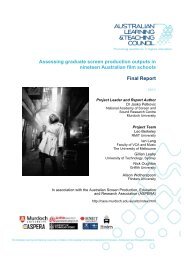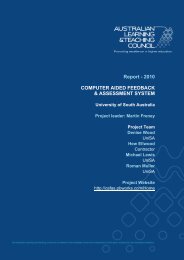10.3 Evaluation1) Kum Leng Chin, Jie Lu, Jun Xu, Jitian Xiao, Juan Yao (2009), Cross culturesteaching <strong>and</strong> learning: Some preliminary findings of an ALTC project.Presented at <strong>Teaching</strong> <strong>and</strong> <strong>Learning</strong> Forum 2009, Curtin University ofTechnology, 29-30 January 20092) Kum Leng Chin, Jie Lu, Jun Xu, Jitian Xiao, Juan Yao (2009), Cross-culturallearning <strong>and</strong> teaching in Australian universities. Presented at 34thInternational Conference on Improving University <strong>Teaching</strong> (IUT),Vancouver, Canada, 14 – 17 July, 20093) Jie Lu, Juan Yao, KL Chin, Jitian Xiao, Jun Xu (2007) Survey analysis oncross culture learning, UTS <strong>Teaching</strong> <strong>and</strong> <strong>Learning</strong> Forum Program, 14 Nov.2007.4) Kum Leng Chin, Lu. J, Juan Yao, Jun Xu, Jitian Xiao (2008), Strategies <strong>and</strong>approaches to teaching <strong>and</strong> learning across cultures. Presented at ALTCworkshop: Investigating the efficacy of culturally specific academic literacy<strong>and</strong> academic honesty resources <strong>for</strong> Chinese students. Victoria University,Melbourne, 29 August 2008.5) Jie Lu, KL Chin, Juan Yao, Jun Xu, Jitian Xiao (2009), Cross-culturalteaching <strong>and</strong> learning methodology analysis <strong>for</strong> asian students in australianuniversities accepted by International Academic Conference on Innovation in<strong>Teaching</strong> <strong>and</strong> Management of High Education (ICITM 2009), 22-24 Dec.2009, Malaysia.6) Jie Lu, KL Chin, Juan Yao, Jun Xu, Jitian Xiao (2010), Cross-culturaleducation: learning methodology <strong>and</strong> behavior analysis <strong>for</strong> Asian students inIT field of Australian universities, accepted by Twelfth AustralasianComputing Education Conference (ACE2010), Brisbane, Australia; 18-22January 2010.7) Jitian Xiao, Jie Lu, KL Chin, Juan Yao, Jun Xu (2010), Challenges <strong>and</strong>strategies in teaching first-year Asian international students in Australianuniversities, accepted by Twelfth Australasian Computing EducationConference (ACE2010), Brisbane, Australia; 18-22 January 2010.8) Jitian XIAO;Jie Lu;KL Chin;Jun Xu;Juan Yao (2010) Cross-cultural learningchallenges <strong>and</strong> teaching strategies <strong>for</strong> first-year Asian students in Australianuniversities, submitted to CSEDU 2010 (International Conference onComputer Supported Education) which will be held in Valencia, Spain nextyear, on 7 - 10 April, 2010.We undertook the <strong>for</strong>mative evaluation in two ways. One was the evaluation donewithin the team; the other was conducted outside the team by experts. Within theteam, <strong>for</strong> example, during the design of the questionnaires, team members firstdesigned the questions, <strong>and</strong> then all others revised the questionnaires via emailbaseddiscussions <strong>and</strong> online document exchange. We also obtained feedback fromoutside the team to improve the outcome of the project in the following ways:• Evaluated by expertsAn expert in cross-cultural teaching <strong>and</strong> learning, Dr. Helen Lu from UTS, readthrough the report <strong>and</strong> wrote an evaluation report (attached).Experts from the Technology & Education Design & Development Research (TEDD)Lab <strong>and</strong> the ELSSA Centre at the University of Technology, Sydney (UTS) providedfeedback to this project.151
Visiting Professor Javier Montero from Complutense University of Madrid (Spain)conducted an evaluation on this project during his visit to UTS in Sep. 2009.Visiting Professor Xiaowei Yang from South China University of TechnologyGuangzhou, P.R. China conducted an evaluation of this project during his visit toUTS in Sep. <strong>and</strong> Oct. 2009.Dr. Tiefeng Zhang has reviewed this project report <strong>and</strong> written an evaluation reportduring his visit to UTS in Nov. 2009Dr. Ruijun Zhang has reviewed this project report <strong>and</strong> written an evaluation reportduring his visit to UTS in Nov. 2009.• Evaluated by studentsWe showed the guidelines to some international students <strong>for</strong> their feedback <strong>and</strong>comments.• Evaluated by colleaguesWe showed the guidelines to some of our colleagues <strong>for</strong> their feedback <strong>and</strong>comments.10.4 Success factor analysisAnalysis of the factors that were critical to the success of the project:1) All team members of the project have experience of international students in theirclasses <strong>and</strong> also of being international students themselves during their study atAustralian universities.2) The involvement of multiple institutes across five Australian universities <strong>and</strong> across IT<strong>and</strong> business fields has provided a more complete picture to the issues faced byinternational students studying in Australia.3) The project collected data from a large number of participants, with more than athous<strong>and</strong> valid survey responses <strong>and</strong> over 50 interviews. This large amount of dataprovided us with a very rich insight to the problems investigated.4) Different types of participants were involved in the project - international students,local students, lecturers <strong>and</strong> graduates. This has enabled us to capture all views on theissues.5) Two constrasting yet complementary data collection methods - survey <strong>and</strong> interview -were employed in this project to ensure both quantitative <strong>and</strong> qualitative data werecollected.6) By drawing conclusions from both quantitative <strong>and</strong> qualitative analyses of the data,we were able to ascertain the validity of our study.7) Student participants came from different study years <strong>and</strong> were majoring in differentareas. This helped to reduce bias in the data collected. At the same time, there was a152
- Page 1 and 2:
Strategies and Approaches toTeachin
- Page 3 and 4:
Table of Contents0 EXECUTIVE SUMMAR
- Page 5:
0 Executive SummaryAustralian terti
- Page 8 and 9:
1 Project OutcomesThe outcomes of t
- Page 10 and 11:
The identification information sect
- Page 12:
questions aim to discover their ass
- Page 15 and 16:
3.2 Literature reviewCross-cultural
- Page 17 and 18:
4 Survey Data AnalysisThis section
- Page 19 and 20:
Total Count 380 632 1012Percentage
- Page 21 and 22:
2 Count 12 30 42Percentage 3.1% 4.7
- Page 23 and 24:
Table 13 shows that nearly all loca
- Page 25 and 26:
methods are good, while less than h
- Page 27 and 28:
Preferredfewerlectures andmore labs
- Page 29 and 30:
Table 26 (Question III.4.D) Preferr
- Page 31 and 32:
Maindifferencesbetweenteachingmetho
- Page 33 and 34:
Table 33 shows that about half of l
- Page 35 and 36:
Table 38 (Question IV.4) Sufficient
- Page 37 and 38:
understanding lectures?Table 42 (Qu
- Page 39 and 40:
confident Count 301 179 480Percenta
- Page 41 and 42:
Table 49 (Question VI.4) Caring abo
- Page 43 and 44:
Table 52 shows that more local stud
- Page 45 and 46:
Table 56 shows that both local and
- Page 47 and 48:
a chi-square test to determine whet
- Page 49 and 50:
Significance Level (α= 0.05)Hypoth
- Page 51 and 52:
presentations are unrelated (Indepe
- Page 53 and 54:
Hypotheses V.2H0: Student category
- Page 55 and 56:
encountered at university in 2/3/4
- Page 57 and 58:
III.7What are you most concerned ab
- Page 59 and 60:
II.6.EII.6.FII.6.GTextbooks you pre
- Page 61 and 62:
VII. OtherVII.1.1VII.1.2What are th
- Page 63 and 64:
III.6 Do you like lecturers to ask
- Page 65 and 66:
distribution of these comments acro
- Page 67 and 68:
Figure 4.5 University of Sydney und
- Page 69 and 70:
Australia is the environment (11.06
- Page 71 and 72:
example, one student said that home
- Page 73 and 74:
5 Interview Data AnalysisThis secti
- Page 75 and 76:
class?Eight students thought studen
- Page 77 and 78:
(1) Did you have any difficulty sel
- Page 79 and 80:
5.2 Staff interview data analysisA
- Page 81 and 82:
(2) Do you think that the methods y
- Page 83 and 84:
is the biggest problem”. One lect
- Page 85 and 86:
comments was, “No, I send them to
- Page 87 and 88:
lecturer, and one of them like the
- Page 89 and 90:
am a shy person I am not comfortabl
- Page 91 and 92:
When they have difficulties in read
- Page 93 and 94:
(7) Have you been involved in many
- Page 95 and 96:
Only two of the graduates had diffi
- Page 97 and 98:
Furthermore, I was not familiar wit
- Page 99 and 100:
ased communication style such as e-
- Page 101 and 102: CrosstabDifficultieswhenreadingtext
- Page 103 and 104: CrosstabPreferred workingin groups
- Page 105 and 106: CrosstabMain differencesbetween tea
- Page 107 and 108: CrosstabWhat are the maindifficulti
- Page 109 and 110: CrosstabDo you have anyEnglish lang
- Page 111 and 112: CrosstabDo you have anyEnglish lang
- Page 113 and 114: CrosstabAre you confidentabout your
- Page 115 and 116: CrosstabDo you have anyEnglish lang
- Page 117 and 118: CrosstabWhat are the mainstudy diff
- Page 119 and 120: Pearson Chi-SquareLikelihood RatioN
- Page 121 and 122: ead lecture notes.2. Regarding the
- Page 123 and 124: II.9 0.022 0.097 0.174 0.02 0.135II
- Page 125 and 126: From Table 65, we can see that ther
- Page 127 and 128: countries peoples. Personally, I fi
- Page 129 and 130: perceived by them as something insi
- Page 131 and 132: 7. Arrange peer groups for those st
- Page 133 and 134: covered (or not covered well) in th
- Page 135 and 136: 13. Ask assistance from internation
- Page 137 and 138: 11) • Weekly groupcase studies an
- Page 139 and 140: 8 Guideline for International Stude
- Page 141 and 142: life. However, it is very important
- Page 143 and 144: There are ways of maintaining focus
- Page 145 and 146: Expect to be nervous initially and
- Page 147 and 148: Avoid cheating and plagiarismAustra
- Page 149 and 150: 9 Disciplinary and interdisciplinar
- Page 151: 10 Results communication, publicati
- Page 155 and 156: 11 ReferencesAsmar C. (1999), Schol
















